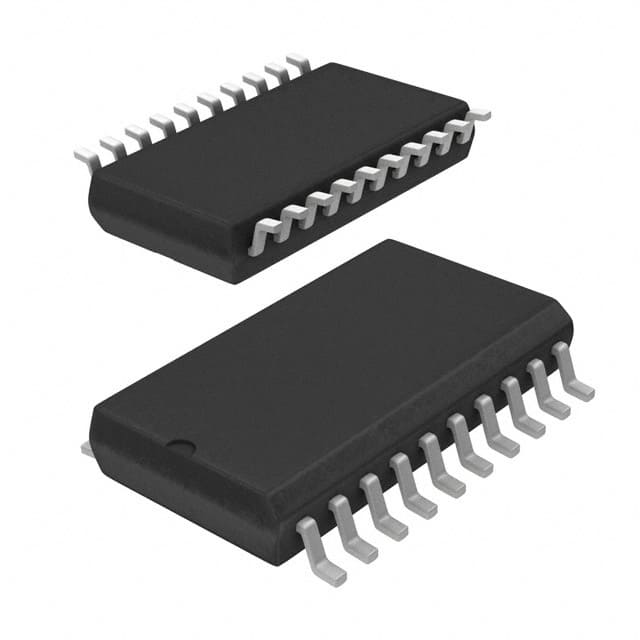Lihat spesifikasi untuk detail produk.

Encyclopedia Entry: 74AHCT541D,118
Product Overview
- Category: Integrated Circuit (IC)
- Use: Signal Buffer/Line Driver
- Characteristics: High-Speed CMOS Octal Buffer/Line Driver with 3-State Outputs
- Package: SOIC-20
- Essence: The 74AHCT541D,118 is a versatile integrated circuit that provides high-speed buffering and line driving capabilities for digital signals. It features eight independent buffer gates with 3-state outputs, making it suitable for various applications.
- Packaging/Quantity: The 74AHCT541D,118 is typically sold in reels or tubes containing multiple units.
Specifications
- Supply Voltage: 4.5V to 5.5V
- Input Voltage: 0V to VCC
- Output Voltage: 0V to VCC
- Operating Temperature: -40°C to +125°C
- Propagation Delay: 6 ns (max)
- Output Current: ±8 mA (max)
Pin Configuration
The 74AHCT541D,118 has a total of 20 pins arranged in a Small Outline Integrated Circuit (SOIC) package. The pin configuration is as follows:
+---\/---+
OE --|1 20|-- VCC
A1 --|2 19|-- A2
B1 --|3 18|-- B2
A3 --|4 17|-- A4
B3 --|5 16|-- B4
A5 --|6 15|-- A6
B5 --|7 14|-- B6
A7 --|8 13|-- A8
B7 --|9 12|-- B8
GND --|10 11|-- Y1
+-------+
Functional Features
- High-speed CMOS technology ensures fast signal propagation and minimal delay.
- 3-state outputs allow for easy bus sharing and connection to multiple devices.
- Buffer gates provide signal amplification and drive capability.
- Wide operating voltage range allows compatibility with various digital systems.
- Low power consumption makes it suitable for battery-powered applications.
Advantages and Disadvantages
Advantages: - Fast propagation delay enables efficient signal transmission. - Versatile 3-state outputs facilitate bus sharing and system integration. - High output current capability allows driving of capacitive loads. - Wide operating temperature range ensures reliability in harsh environments.
Disadvantages: - Limited number of buffer gates may restrict the number of signals that can be processed simultaneously. - Requires external pull-up or pull-down resistors for proper operation in certain configurations.
Working Principles
The 74AHCT541D,118 operates by receiving digital input signals on its A1-A8 pins. These signals are then buffered and amplified by the internal gates. The output signals appear on the Y1 pin when the Output Enable (OE) pin is active. When the OE pin is inactive, the outputs are in a high-impedance state, allowing other devices to drive the bus.
Application Field Plans
The 74AHCT541D,118 finds applications in various fields where signal buffering and line driving capabilities are required. Some potential application areas include: - Data communication systems - Industrial automation - Automotive electronics - Consumer electronics - Robotics
Alternative Models
- 74HC541: Similar functionality but operates at a higher voltage range (2V to 6V).
- SN74LVC541A: Low-voltage version with improved noise immunity and lower power consumption.
- CD4050: Hex non-inverting buffer with a wider supply voltage range (3V to 18V).
Note: The above alternative models are provided as examples and may have different pin configurations and specifications. It is recommended to refer to their respective datasheets for detailed information.
This comprehensive entry provides an overview of the 74AHCT541D,118 integrated circuit, including its category, use, characteristics, package, and essence. It also covers specifications, pin configuration, functional features, advantages and disadvantages, working principles, application field plans, and alternative models.
Sebutkan 10 pertanyaan dan jawaban umum terkait penerapan 74AHCT541D,118 dalam solusi teknis
Sure! Here are 10 common questions and answers related to the application of 74AHCT541D,118 in technical solutions:
Q: What is the 74AHCT541D,118? A: The 74AHCT541D,118 is a octal buffer/line driver with 3-state outputs, commonly used in digital logic circuits.
Q: What is the maximum operating voltage for the 74AHCT541D,118? A: The maximum operating voltage for the 74AHCT541D,118 is 5.5V.
Q: How many inputs and outputs does the 74AHCT541D,118 have? A: The 74AHCT541D,118 has 8 inputs and 8 outputs.
Q: Can the 74AHCT541D,118 be used as a level shifter? A: Yes, the 74AHCT541D,118 can be used as a level shifter to convert signals between different voltage levels.
Q: What is the purpose of the 3-state outputs in the 74AHCT541D,118? A: The 3-state outputs allow multiple devices to share a common bus without interfering with each other.
Q: What is the maximum output current that the 74AHCT541D,118 can drive? A: The 74AHCT541D,118 can drive up to 35mA of current per output.
Q: Can the 74AHCT541D,118 be used in high-speed applications? A: Yes, the 74AHCT541D,118 is designed for high-speed operation and can be used in such applications.
Q: Is the 74AHCT541D,118 compatible with TTL logic levels? A: Yes, the 74AHCT541D,118 is compatible with both TTL and CMOS logic levels.
Q: Can the 74AHCT541D,118 be used in bidirectional data transfer applications? A: No, the 74AHCT541D,118 is a unidirectional buffer and cannot be used for bidirectional data transfer.
Q: What is the recommended operating temperature range for the 74AHCT541D,118? A: The recommended operating temperature range for the 74AHCT541D,118 is -40°C to +125°C.
Please note that these answers are general and may vary depending on the specific application and requirements.

